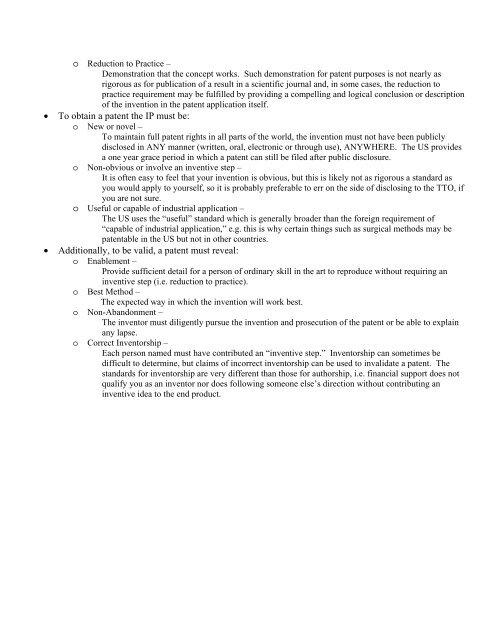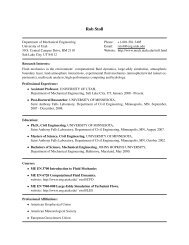University of Utah Technology Transfer Office Handout
University of Utah Technology Transfer Office Handout
University of Utah Technology Transfer Office Handout
You also want an ePaper? Increase the reach of your titles
YUMPU automatically turns print PDFs into web optimized ePapers that Google loves.
o Reduction to Practice –<br />
Demonstration that the concept works. Such demonstration for patent purposes is not nearly as<br />
rigorous as for publication <strong>of</strong> a result in a scientific journal and, in some cases, the reduction to<br />
practice requirement may be fulfilled by providing a compelling and logical conclusion or description<br />
<strong>of</strong> the invention in the patent application itself.<br />
• To obtain a patent the IP must be:<br />
o New or novel –<br />
To maintain full patent rights in all parts <strong>of</strong> the world, the invention must not have been publicly<br />
disclosed in ANY manner (written, oral, electronic or through use), ANYWHERE. The US provides<br />
a one year grace period in which a patent can still be filed after public disclosure.<br />
o Non-obvious or involve an inventive step –<br />
It is <strong>of</strong>ten easy to feel that your invention is obvious, but this is likely not as rigorous a standard as<br />
you would apply to yourself, so it is probably preferable to err on the side <strong>of</strong> disclosing to the TTO, if<br />
you are not sure.<br />
o Useful or capable <strong>of</strong> industrial application –<br />
The US uses the “useful” standard which is generally broader than the foreign requirement <strong>of</strong><br />
“capable <strong>of</strong> industrial application,” e.g. this is why certain things such as surgical methods may be<br />
patentable in the US but not in other countries.<br />
• Additionally, to be valid, a patent must reveal:<br />
o Enablement –<br />
Provide sufficient detail for a person <strong>of</strong> ordinary skill in the art to reproduce without requiring an<br />
inventive step (i.e. reduction to practice).<br />
o Best Method –<br />
The expected way in which the invention will work best.<br />
o Non-Abandonment –<br />
The inventor must diligently pursue the invention and prosecution <strong>of</strong> the patent or be able to explain<br />
any lapse.<br />
o Correct Inventorship –<br />
Each person named must have contributed an “inventive step.” Inventorship can sometimes be<br />
difficult to determine, but claims <strong>of</strong> incorrect inventorship can be used to invalidate a patent. The<br />
standards for inventorship are very different than those for authorship, i.e. financial support does not<br />
qualify you as an inventor nor does following someone else’s direction without contributing an<br />
inventive idea to the end product.





